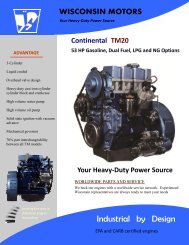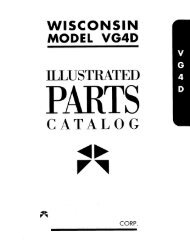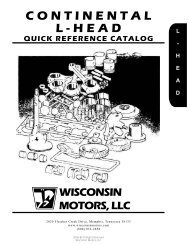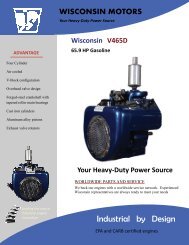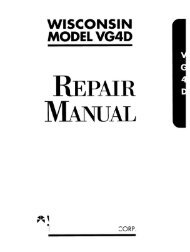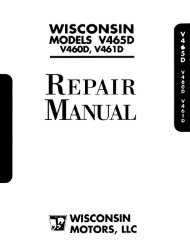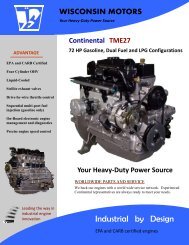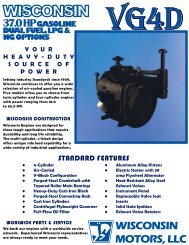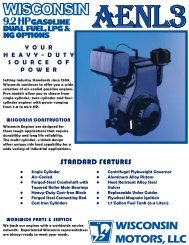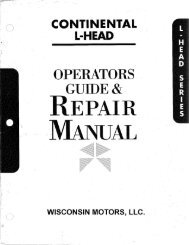REPAIR MANUAL - Wisconsin Motors
REPAIR MANUAL - Wisconsin Motors
REPAIR MANUAL - Wisconsin Motors
- No tags were found...
Create successful ePaper yourself
Turn your PDF publications into a flip-book with our unique Google optimized e-Paper software.
esult in injurious sludge formation. It is vitally important<br />
therefore to maintain oil and crankcase<br />
temperatures above 57°C (135°F.) as shown<br />
the following chart:<br />
Use the checklist which follows to get your engine<br />
ready for winter. Then use the winter maintenance<br />
schedule to keep it in peak operating condition<br />
during the winter months.<br />
REACTIONS WITHIN ENGINE CRANKCASE<br />
TO TEMPERATURES DURING OPERATION<br />
/ WARNING<br />
F<br />
250<br />
°.<br />
2oo’.<br />
15o<br />
°<br />
.<br />
loo’,<br />
50"<br />
32"<br />
o<br />
CLEAN<br />
ENGINE<br />
OPERATION<br />
LIQUID CONDENSATION S=udg=no, Etching of Parts,<br />
Ring and Valve Sticking and<br />
Burning of Bearings.<br />
666<br />
SNOW - ICE<br />
Sludge and Freezing of Oil Screens<br />
and Pumps - Resulting in Burned<br />
Bearings and Stripped Pump Gears.<br />
c<br />
176.6"<br />
148.9"<br />
121.1"<br />
93.3"<br />
65,5<br />
°<br />
37.7"<br />
10"<br />
0"<br />
-17.8"<br />
45.6"<br />
When sludging conditions prevail, the oil should be<br />
examined daily and changed as it may freeze, or clog<br />
the inlet strainer and cause bearing or oil pump<br />
failures.<br />
High Altitude Operation--if engine is to be run<br />
continuously at a high altitude (above 5000 ft.) the<br />
pump calibration should be modified to maintain an<br />
acceptable smoke level. Contact manufacturer for<br />
recommendations.<br />
Note: Some high altitude fuel delivery curve shaping<br />
can be performed on some STANADYNE fuel injection<br />
pumps in the field (see pg. 30).<br />
High Temperature Operation--for every 5°C<br />
(10°F.) above 29.4°C (85°F.) inlet air temperature--<br />
a power loss of 1% results.<br />
ENGINE PREPARATION FOR WINTER USE<br />
CHECKLIST<br />
Stop engine before checking battery terminals or electrical<br />
connections. Sparks or flames near a battery<br />
could cause an explosion or fire. Battery acid can cause<br />
corrosive burns. Always wear eye protection. Use of<br />
jumper cables or battery charging should be done only<br />
as directed by manufacturers’ safety instructions.<br />
Read and observe safety warnings on pages 1 and 2.<br />
1. ELECTRICAL SYSTEM<br />
A. Battery - replenish water and test for condition<br />
and state of charge. Replace if required.<br />
Wiring - check battery cables, connections and<br />
other wiring. Be sure connections are clean<br />
and tight and that cables and wiring insulation<br />
are in good condition.<br />
Alternator and regulator-run the engine and<br />
check the ammeter to be sure the alternator is<br />
charging and the regulator is functioning properly.<br />
Check and adjust alternator belt tension.<br />
2. COOLING SYSTEM<br />
/ WARNING<br />
If the coolant is hot or if the engine has been running,<br />
loosen the pressure cap to the first stop and let the<br />
pressure out o! the cooling system before removing the<br />
radiator cap.<br />
Read and observe safety warnings on pages 1 and 2.<br />
A. Check radiator, hoses and engine for water<br />
leaks. Tighten hose clamps, repair leaks and<br />
install antifreeze to the level required for<br />
winter protection.<br />
More than 90% of the hard starting complaints<br />
in cold weather are the direct result of inadequateattention<br />
to preparation for winter use and proper<br />
maintenar~ce. An engine not properly prepared requires<br />
more cranking energy and time, which puts<br />
a heavy load on batteries. So, invariably, batteries<br />
run down and the engine is blamed for hard starting.<br />
Putting your engine in proper condition and<br />
keeping it that way pays big dividends by reducing<br />
costly down time.<br />
3. LUBRICATION SYSTEM<br />
Add oil of the pro-<br />
A. Drain oil and change filter.<br />
per winter grade.<br />
B. There are several different types and<br />
manufacturers of transmissions and powertake-offs.<br />
Caution should be used when<br />
determining the proper seasonal grade lubricant<br />
to assist in cold weather starting.<br />
10



